Changing Tourism Trends and Vulnerability Assessment of Built Environment in Hill Stations of Indian Himalayan Region.
1
Department of Architecture,
Ramaiah Institute of Technology, Bangalore,
Visvesveraya Technological University, Belagavi,
Karnataka
India
Corresponding author Email: 515.shubhra@gmail.com
Copy the following to cite this article:
Pande S, Bhardwaj M. Changing Tourism Trends and Vulnerability Assessment of Built Environment in Hill Stations of Indian Himalayan Region. Curr World Environ 2024;19(1).
Copy the following to cite this URL:
Pande S, Bhardwaj M. Changing Tourism Trends and Vulnerability Assessment of Built Environment in Hill Stations of Indian Himalayan Region. Curr World Environ 2024;19(1).
Citation Manager Publish History
Select type of program for download
| Endnote EndNote format (Mac & Win) | |
| Reference Manager Ris format (Win only) | |
| Procite Ris format (Win only) | |
| Medlars Format | |
| RefWorks Format RefWorks format (Mac & Win) | |
| BibTex Format BibTex format (Mac & Win) |
Article Publishing History
| Received: | 2023-08-07 |
|---|---|
| Accepted: | 2024-03-14 |
| Reviewed by: | 
 Eman H. Khader
Eman H. Khader
|
| Second Review by: |

 S. P Rajaveni
S. P Rajaveni
|
| Final Approval by: | Dr. Rui Alexandre Castanho |
Introduction
In the period between 2019 and 2028, the Indian tourism and travel industry is anticipated to grow at a rate of 10.35% annually 1. Pertaining to the rich natural and built heritage of India, the tourism trend has inclined more domestic tourism post the COVID -19 pandemic. The Indian Himalayan Region (IHR), with 10% of its income from tourism, extends up to 2400 Km over an area of 500,000 sq. Km 2.
The tourism trend in the Himalayan region of India has changed over the last decade. The tourist visits (locally called the season) to hill stations were prominent during the summer months of May to July. The global climate change has resulted in increased temperature of the plains area, resulting in an increased tourist footfall in hill stations throughout the year. Fig-1 shows the forecast for arrival of tourists in the IHR states by 2025 2. Availability of tourism infrastructure and increased per capita income has further strengthened the tourist footfall to IHR by easing travel opportunities. Post COVID 19 pandemics, there has been an increase in the number of domestic tourists across the income groups visiting IHR.
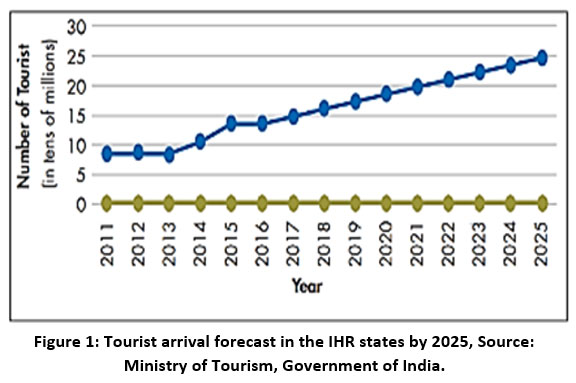 | Figure 1: Tourist arrival forecast in the IHR states by 2025, Source: Ministry of Tourism, Government of India.
|
Tourism destination preferences of tourists within the age group of 18 to 40 years has changed towards serene and calm surroundings rather than the crowded hilly stations. The study concluded by Yuni, LK Herindiyah Kartika, explains the preferred tourism type among this age group to be nature tourism, as shown below in Table 13. The remote working options has facilitated staycation stays in calm surroundings. A trend towards shift to staycation friendly destinations rather than crowded weekend-stay locations has been observed over the recent years.
Table 1: Tourist preference trends post-pandemic by Yuni, LK Herindiyah Kartika.
Parameter studied | Tourist preference |
Age group preferred to travel for tourism | 26-45 years old |
Female tourists | 52.2% |
Undergraduate | 49.1% |
Private Employees | 38.07% |
Preferred stay | Cheap homestays |
Preferred type of tourism | Nature tourism (58.7%) |
Global climate change has a major impact on tourism demand due to seasonal variations in both plains and hilly areas. Climate change has been considered one of the 4Ps in the suggested framework for Analysis and Action in sustainable tourism as per NITI Aayog 2. Fig-2, Shows the framework, emphasizing consideration of climate change.
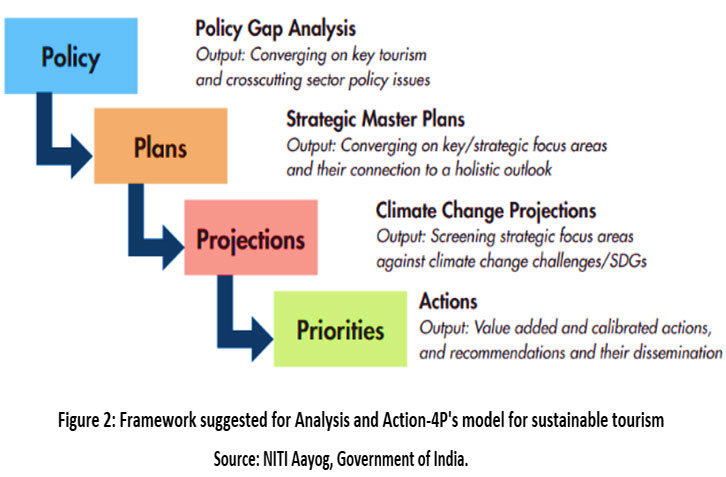 | Figure 2: Framework suggested for Analysis and Action-4P's model for sustainable tourism
|
Source: NITI Aayog, Government of India.
The trend towards scenic tourism and overcrowding of the famous hill towns like Shimla, Mussoorie and Nainital has led to several new tourist hotspots in the vicinity of the old hill stations. This has caused several urban issues related to parking, unauthorised construction, overcrowding, solid waste disposal and water problems 4. Municipalities must respond proactively at multiple scales towards maintaining the basic urban infrastructure and provision for service functions, as the shifting climate factors will multiply the effects on the cities 5.
The unplanned tourism infrastructure growth and the ignorance of tourism Carrying capacity in these fragile ecosystems have further resulted in disaster vulnerability due to flooding and landslides. The multiple dimensions of vulnerability are defined as physical, social and economic. The physical dimension is related to direct costs and impacts human lives through various threats. Several researches have emphasized vulnerability curves over other methods and approaches (vulnerability matrices and vulnerability indices) to assess the vulnerability of mountain hazard risk management 6.
The study area chosen as a case study in this research is Shimla district in Himachal Pradesh. The identification of upcoming hotspots based on changing climatic and tourism trends along with the growing demand for the development of fast tourist infrastructure has been used for vulnerability assessment of the built environment. The proposals for tourism infrastructure projects in the fragile and ecologically sensitive region of IHR need consideration of the possible risks along with the incorporation of a suitable change management approach. These project management parameters when accounted for the feasibility and appraisal of the projects, further demand adapting the computerised tools. The study suggests the use of Real-Time Systems, Intelligent Transport Systems and Neural networks projects for appraisal and feasibility analysis of tourism infrastructure projects in vulnerable hotspots.
Research Methodology
The data collection comprises two parts. The first part reviews the existing literature on tourism trends in IHR from secondary sources including government proposals and reports, tourist statistics, weather data and tourism websites. In the next part, considering the case of Shimla, Himachal Pradesh, the relationship between tourist arrival statistics, changing climate and tourism demand is established. The vulnerability assessment of the built environment in hill stations is done for tourist hotspots in the study region. Once the need for a structured approach toward tourism infrastructure development in vulnerable tourist hotspots is established, the need for the project feasibility is explored. This is done through discussion on the applications of computerized tools- Real-Time Systems, Intelligent Transport Systems and Neural networks projects, towards appraisal and feasibility analysis of tourism infrastructure projects in vulnerable hotspots. The study concludes with a suggested process for vulnerability assessment of the built environment based on 3 parameters i.e., Changing tourist arrival statistics, changing climatic trends and changing tourist preferences, leading to the demand for new tourist destinations in IHR. The consideration of the fragile ecosystem of IHR along with the risk and change management-based approach has been emphasized. A structured feasibility and appraisal of the projects is suggested to achieve a tourism project-specific vision for IHR.
Literature study on changing tourism trends in IHR.
Climate change impacting the tourism destination demands
Shimla region in Himachal Pradesh has been experiencing a gradual increase in its annual minimum temperature. On average, the temperature has been increasing by 0.45ºC annually, from 8.65°C in 2001 to 12.70°C in 2009. This indicates a clear change in the climate of the region7. Climate changes recorded in Shimla Meteorological Centre are shown in Table 2.
Table 2: Climatology of Shimla, Meteorological Centre, Shimla
| Climatology of Shimla | |
| Average annual maximum temperature | 18.4ºC |
| Average annual minimum temperature | 10.2ºC |
| Lowest average monthly minimum temperature -January | 2.5ºC |
| Highest average monthly minimum temperature -June | 24.3ºC |
| Annual rainfall | 1415mm |
| Highest monthly rainfall | July |
| Ever highest Maximum temperature on 27.05.2010 | 32.4ºC |
| Ever lowest Minimum temperature on 11.01.1945 | -10.3ºC |
Climate change has been documented in another hill station, Kullu in Himachal Pradesh. Raj Pal Meena and P R Kumar stated that over the last 2 decades, the phenomenon of regular snowfall in Kullu has been changed to only 2-3 recorded snowfall instances. According to the recorded data, the Kullu valley experienced a rise in its average maximum temperature by 0.58 ºC between the years 1963 and 2007. Similarly, the average minimum temperature also increased by 2.75ºC. During December, January and February, which are sensitive to cold weather, the average minimum temperature has gone up by 2.27, 2.68 and 3.63 ºC, respectively 8. The prolonged winter season with little snowfall and changes in the average minimum and maximum temperatures, has impacted seasonal tourism trends such as winter tourism along the Indian Himalayan Region 9. These trends are impacted by the tourist preferences for destinations and tourism categories.
Need for Tourism infrastructure provisions as per the changing tourism trends in IHR
Colonial hill stations like Shimla, Nainital and Mussoorie were developed with well-planned infrastructure provisions that served the tourism needs for a reasonable duration. Over the recent decades mass tourism and unregulated infrastructure provisions in these hill stations has resulted in several urban issues 4. The existing infrastructure cannot cater to the increased tourist demands and has led to changing preferences towards tourist destinations.
Tourists prefer calm locations for longer duration staycations and visit the existing famous tourist destinations for a shorter duration. Hotspots along the less explored scenic landscapes have emerged in the vicinity of existing hill stations. The demand for nature tourism has led to emergence of tourism infrastructure projects in these hotspots. There lies a gap between the tourist demand and tourist carrying capacity of the fragile ecosystems of IHR. Tourism is a demand-based industry and planning for infrastructure needs a structured approach towards understanding the changing tourism trends.
Study of changing trends based on tourist arrival statistics in IHR
The changing trend towards the tourist hotspots can be understood through two perspectives. First is the tourist demand towards unexplored hill sites and destinations. Second is the tourism infrastructure development and availability of government subsidies and financial loans to encourage tourism in these locations. The increase in tourism demand can be observed in Fig. 3, based on data collected along the different states of IHR 2. The data shows that Himachal Pradesh received the third highest tourist arrival between 2011-2015.
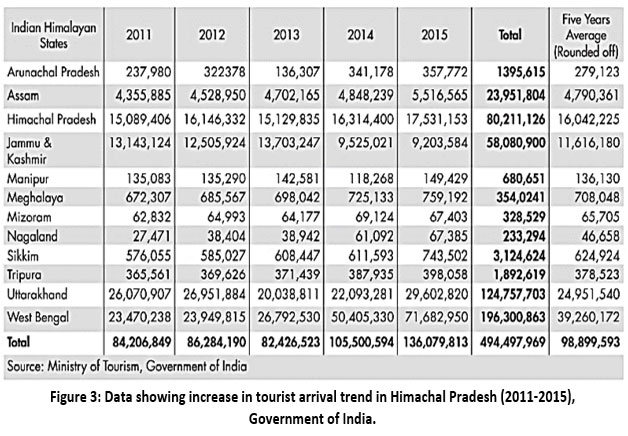 | Figure 3: Data showing increase in tourist arrival trend in Himachal Pradesh (2011-2015), Government of India.
|
Government initiatives and plans for tourism infrastructure development
Tourism has the capacity to contribute to all of the Sustainable Development Goals (SDGs). It has been recognized as a target in three SDGs i.e., Goal 8 (promote inclusive and sustainable economic growth), Goal 12 (sustainable consumption and production -SCP), and Goal 14 (sustainable use of oceans and marine resources) [10]. Sustainable tourism is a part of 2030 Agenda. Government of India has initiated several schemes for aiding the tourism infrastructure development projects. These include Pilgrimage Rejuvenation and Spiritual Augmentation Drive (PRASAD), Himalayan Circuit, SWADESH DARSHAN, North-East (NE) India Circuit and Spiritual Circuit and the projects funded by Asian Development Bank under Infrastructure Development Investment Program for Tourism (IDIPT). In Himachal Pradesh, 30 tourism infrastructure projects with the total cost of INR 619 Crores have been funded under IDIPT 11. The development of tourism infrastructure has been encouraged through government aided schemes.
The challenging and tough terrain of IHR along with disaster vulnerability, ecological conditions and accessibility issues of road networks cause delays in project schedule as compared to projects in the plains. This has impacted the tourism infrastructure projects with fund lapse, where the allocated budget is not utilised within the stipulated time. The majority of the projects are also impacted due to low fund release of up to 50% [2]. As mentioned in the analysis by Tri Academy, these policies along with national and international market pressures, contribute to land degeneration in large scales 12.
The increasing gap between demand and supply of tourism infrastructure provision due to increased mass tourism has led to several socio-cultural issues. According to the NITI Aayog report, the natural and cultural beauty of the Himalayas is undervalued, and the region is being developed like the plains of India 2. It suggests that the generic standards of certification or conduct of tourism-related services and products need refinement /design. This requires collaboration between ministries of tourism and culture forest and climate change, mountain states, business sectors and the stakeholders involved form international and national organizations, private investors, community representatives, and financing corporations 2.
Study Area
Case Study for the Vulnerability assessment of tourist destinations has been done around famous tourist destinations in and around Shimla, Himachal Pradesh. It is based on the tourist arrival statistics, changing climate trends and study of tourism trends and government initiatives for upcoming hotspots in the vicinity of the study area. The new tourist destinations are vulnerable to the risks of over-tourism and unplanned infrastructure development. There is a need to address the tourism demands through proper feasibility and appraisal of proposed tourism infrastructure development projects. A study on hazards related to the built environment has highlighted challenges in conducting vulnerability assessments. It has emphasized the importance of data requirements for uncertainties, improved event documentation, and challenges related to future climate and socio-economic changes.
Study of statistics on tourist visits in the study area.
The study of tourist statistics for 2012-2021 for Himachal Pradesh and Shimla district, from the Himachal tourism website, shows the increasing tourism demand [13]. The impact of the Pandemic on tourist arrival numbers in Shimla and Himachal Pradesh is evident from Table 3 and Table 4 respectively.
Table 3: Tourist statistics in Shimla and Himachal Pradesh from 2012-2021, Himachal tourism website.
YEAR | SHIMLA (TOURIST VISIT) | HIMACHAL PRADESH | ||
DOMESTIC | FOREIGN | TOTAL | TOTAL TOURIST VISIT | |
2012 | 3,195,332 | 9068 | 32,04,400 | 1,61,46,332 |
2013 | 29,92,991 | 1,64,006 | 31,56,997 | 1,51,29,835 |
2014 | 31,93,637 | 1,56,235 | 33,49,872 | 1,63,14,400 |
2015 | 32,61,152 | 1,54,155 | 34,15,307 | 1,75,31,153 |
2016 | 34,16,629 | 1,65,476 | 35,82,105 | 1,84,50,520 |
2017 | 33,18,829 | 1,62,168 | 34,80,997 | 1,96,01,533 |
2018 | 28,72,013 | 1,23,000 | 29,95,013 (13.96% drop from 2017) | 1,64,50,503 (16.08% drop from 2017) |
2019 | 30,30,246 | 1,32,608 | 31,62,854 | 1,72,12,107 |
2020 | 5,99,202 | 21,111 | 6,20,313 | 32,13,379 |
2021 | 9,51,792 | 825 | 9,52,617 (increased by 53.57%) | 56,37,102 (increased by 75.43%) |
The data recorded for the span of 10 years (2012-2021), shows that there has been a reduction in tourist arrival during the year 2018 and 2020. It is observed that the state of Himachal Pradesh (H.P.) experienced a drop of 16.08% in the number of tourist visits, however Shimla experienced a drop of 13.96% during 2018.
Considering the recent changes in the tourist demand trends the post- pandemic tourist arrival rate has been analysed for the study. Post pandemic, in the year 2021 the increased percentage in number of tourists in H.P. is 75.43% (77.63% increase in Domestic and 88.67% decrease in foreign tourists), whereas the same for Shimla is 53.57% (58.8% increase in domestic and 96.1% decrease in international tourists), Table 4.
Table 4: Percentage change in tourists during 2018 and 2021
| Domestic | International | Percentage change |
2020 (decreased tourist arrival) | |||
SHIMLA | 599202 | 21111 | -15.87% |
H.P. | 16093935 | 356568 | -24.29 |
2021 (increased tourist arrival) | |||
SHIMLA | 951792 | 825 | 53.57% |
H.P. | 5632270 | 4832 | 75.43% |
To analyse the changing tourist trend, the tourist visits to Shimla district have been compared to the visits to districts of Kullu and Lahaul & Spiti in Himachal Pradesh in Table 5. The data for 2019 and 2021 had been compared to trace the change in tourist demand from built to natural heritage. More tourists visited Lahaul & Spiti and Kullu for scenic tourism as compared to the overcrowded hill station of Shimla in the post-pandemic year- 2021.
Table 5: Changing trend in tourist visits based on destination preferences.
| DOMESTIC | INTERNATIONAL |
2019 | ||
SHIMLA | 3030246 | 132608 |
KULLU | 3056463 | 102948 |
LAHAUL & SPITI | 118035 | 14948 |
2021 | ||
SHIMLA | 951792 | 825 |
KULLU | 1647329 | 252 |
LAHAUL & SPITI | 960532 | 420 |
Climate change trend in the study area.
The vulnerability of hazardous processes are indirectly influenced through changes in precipitation and temperature variations 14. The End of Season Report of Himachal Pradesh for Southwest Monsoon gives data on changing monsoon trends in the State from 2004 to 2022. A negative anomaly has been indicated except the years 2010 and 2018, in the seasonal monsoon (June- September), as shown in Fig.4 15. Across the monsoon period of June to September, excess rainfall is documented in the months of September, 2018.
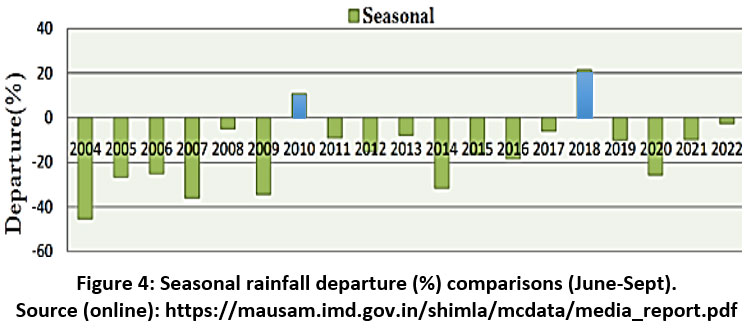 | Figure 4: Seasonal rainfall departure (%) comparisons (June-Sept).
|
Source (online): https://mausam.imd.gov.in/shimla/mcdata/media_report.pdf
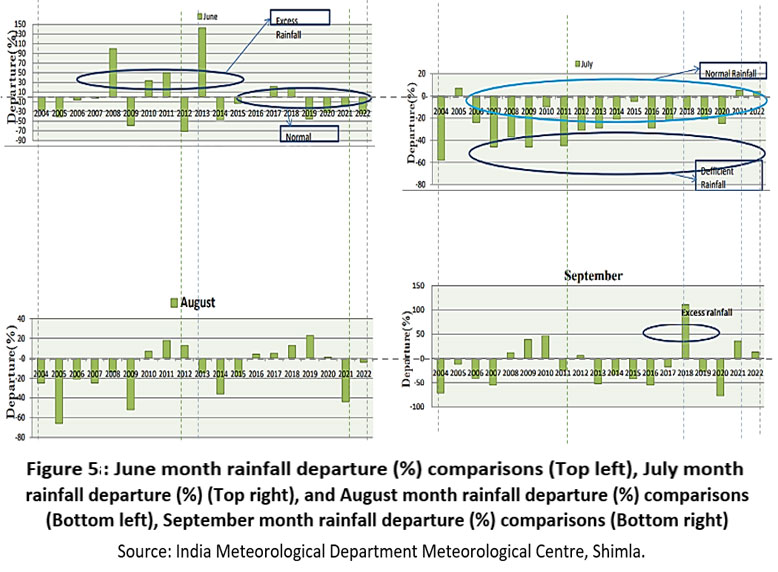 | Figure 5: June month rainfall departure (%) comparisons (Top left), July month rainfall departure (%) (Top right), and August month rainfall departure (%) comparisons (Bottom left), September month rainfall departure (%) comparisons (Bottom right).
|
Source: India Meteorological Department Meteorological Centre, Shimla.
In Himachal Pradesh, as per the statement on climate for 2021, 8 districts out of the 12, received normal rainfall and 1 district received excess rainfall of 20% to 60%. 3 districts received insufficient rainfall, as per the reports 15.
The average annual temperature of Himachal Pradesh has risen in comparison to the last 3 decades. The land surface air temperature (averaged mean) for annual data was 0.8o C warmer in 2021 as compared to its Long Period Average for 1981-2010. Fig. 6 shows the air temperature anomalies for 1901-2021. A rise in temperature during 2018 is depicted in the annual mean temperature. The climate trend in Shimla over the last 4 decades reflects an increase in temperature and rainfall during 2018.
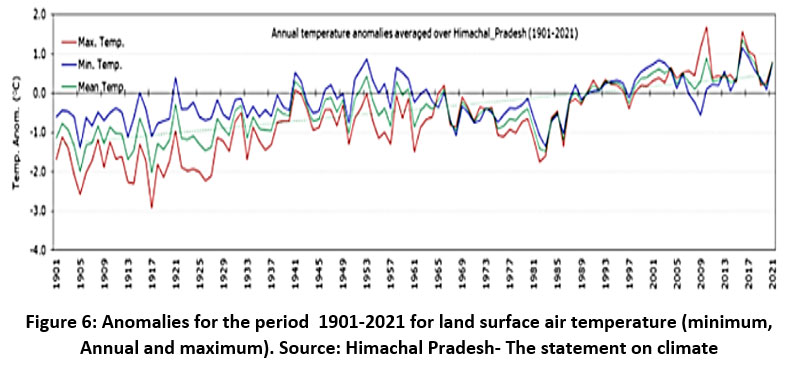 | Figure 6: Anomalies for the period 1901-2021 for land surface air temperature (minimum, Annual and maximum). Source: Himachal Pradesh- The statement on climate
|
On comparing the observations of changing climate trends to the tourist statistics, the vulnerability of the tourism specific built environment in Indian Himalayan region can be assessed. The changes in land use and demography adds further pressure for mountain environment in addition to that posed by climatic conditions 16. The increased tourist arrival to these new destinations creates demand for immediate infrastructure provisions, thus increasing vulnerability to risks associated with over tourism, changing climatic concerns and tourism demand. Vulnerability of natural hazards on mountain communities is further increased due to drivers such as urbanization, degradation and deforestation 17.
Results and Discussion
The comprehensive project report for the International Monetary Fund (IMF) mentions about estimated 13 to 65 lacs INR funding to be made towards the project by Himachal Pradesh government. The IMF report proposes promoting nearby areas such as Tandali, Chanshal, Pujarali, Rohru, Tangnu, Banchu, Tikkar, Sharog, Chirgaon, Barasli, Ratandi, Dodrakawar and Sharog to complement the existing hill station of Shimla 18. Fig. 7 shows the mapping of possible upcoming tourist hotspots around Shimla town as per the proposal for IMF funding. These destinations will need tourism-specific vision and an appraisal of tourism infrastructure projects for successful project implementation.
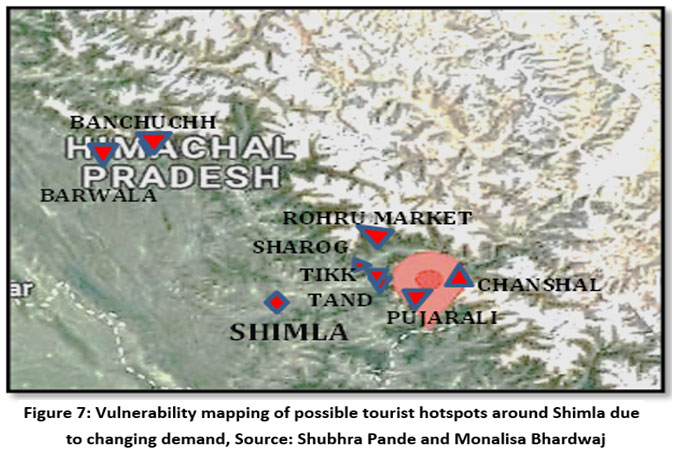 | Figure 7: Vulnerability mapping of possible tourist hotspots around Shimla due to changing demand, Source: Shubhra Pande and Monalisa Bhardwaj
|
Vulnerability assessment based on changing preferences of tourists
Successful implementation of tourism infrastructure projects requires understanding the dynamic tourist demands and stakeholder interests. The recently changed tourist preference from the built heritage of the famous colonial hill stations to the natural heritage and serene environment of nearby destinations has been observed through analyzing the tourist arrival statistics of Shimla. This change in trend has impacted the framework of packaged tours offered by the travel and tourism industry. A glance at the latest tourism-related websites and advertisements in the IHR region includes activities based on trekking, pilgrimage and nature tourism in previously unexplored scenic destinations that are now transforming into tourist hotspots 19.
The treks in Himachal Pradesh, where tourist inflow has increased include Brighu Lake Trek, Beas Kund Trek, Lamadugh Trek, Kheerganga Trek, Hampta Pass- Chandratal Lake, Malana- Chandrakhani Trek, Deo Tibba Base Camp and Pin Parvati Trek 19.
The changing rate of tourist arrival, climate changes and tourist preferences can lead to the vulnerability of the built environment in the tourism hotspots. Vulnerability assessment using these three parameters will contribute towards tourism-specific vision for infrastructure development projects. The next step towards project initiation will be the feasibility and appraisal of proposed tourism infrastructure projects. In hilly regions of IHR, the feasibility assessment needs to consider the fragile ecosystem along with the management of changes and risks.
Use of Real Time Systems, Intelligent Transport Systems and Neural Networks in feasibility and appraisal of Tourism infrastructure projects in IHR.
Successful planning and implementation of tourism projects in IHR depends on the vulnerability assessment, as the degree to which the infrastructure can be adversely impacted due to changing climate and tourism trends 20. Once the vulnerability assessment is completed based on the changing trends of tourism arrival, climate and tourist demand analysis, the feasibility and appraisal of the proposed tourism infrastructure projects needs to be done. This needs consideration of fragile hilly areas, change management, risk management, geographical limitations and triple constraints of project management (budget, schedule, scope).
Studies have shown that internet-based systems or internet-related information technology solutions have been useful in construction projects 21. “Total Information Transfer System” (TITS) is one such solution that offers information sharing efficiency through an internet-based project management system, towards performance management to construction firms 21. Tourism being a demand-based industry, depends on the changing preferences of the user group. The understanding of ever-changing demand can be used to identify the infrastructure preferences for successful and profitable returns on investment of tourism infrastructure. The use of neural networks based on the likes and dislikes of tourists can become an important parameter in the performance management of a project 22,23.
The infrastructure projects funded by international funding agencies involve the methodology of pilot projects. The use of Real-time systems in the construction industry improves the efficiency and profitability of the project by providing relevant updates for finance management, change management and risk management 24. The consideration of these systems during pilot tourism infrastructure projects in the new hotspots will help in risk identification and can reduce the challenges of scope creep and delays in tourism projects of IHR.
The resulted identified vulnerable locations in the chosen case study are near the existing tourist hub, Shimla. This shows that the tourism demand for these hotspots will depend on the accessibility and transport networks linking them to existing tourist facilities in Shimla. The provision of built environment and infrastructure should consider the tourism carrying capacity of IHR's fragile geography. The use of Intelligent Transport systems can fill the gap between the tourist carrying capacity and allowable tourist footprints during the different seasons and changing climate trends. This can facilitate in ecological risk identification, thus smooth and safe tourist inflow to upcoming tourist hubs.
The concept of smart tourism involves use of internet-based applications and tools to improve the tourism project performance 25. Computer-based technologies like Real Time Systems, Intelligent Transport Systems and Neural Networks can be used for project feasibility and appraisal in IHR tourism infrastructure projects. Fig. 8 explains the proposed process of vulnerability assessment, feasibility and appraisal of tourism infrastructure projects in IHR, based on the case study of tourism hotspots near Shimla.
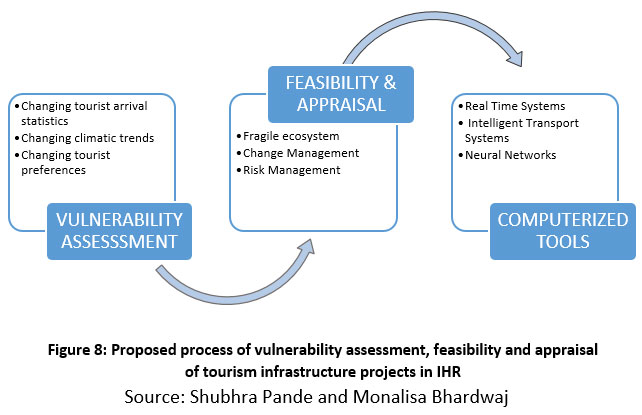 | Figure 8: Proposed process of vulnerability assessment, feasibility and appraisal of tourism infrastructure projects in IHR
|
Source: Shubhra Pande and Monalisa Bhardwaj
Changing trends of tourism in IHR
The increasing demand for tourist hotspots in scenic locations for nature-based tourism has led to a change in the trends of tourism in IHR. This includes adventure and pilgrimage tourism, resulting in a 28.78% increase in tourist arrivals from 2002 to 2013. The statistics show an increase in tourist arrivals during winter and the impact of climate change on winter tourism preferences26.
Due to the trend of adventure tourism and staycations, the number of domestic tourists has increased. There has been a growth in domestic tourism (2019-20) in Himachal Pradesh by 4.57% and a 5.51% increase in Shimla27. The hilly region relies heavily on tourism as one of its main sources of income. To encourage tourism, several government policies and incentives, such as eco-tourism schemes, have been implemented.
According to records from 2019, the overall tourist arrival has increased to 1.6 times the existing population 28. The changing tourist trends that have led to increased vulnerability in IHR, have been shown in Table 6.
Table 6: Changing tourism trends in IHR
| Tourist Trend | Changing tourist demands resulting in trends |
| Increased demand for nature-based tourism | Average annual growth of 28.78% in tourist arrival from 2002 to 2013 due to increasing trend for adventures and pilgrimage tourism. |
| Preference for winter tourism in IHR | Foreign tourist Arrival statistics show max visit in winters |
| Increased number of homestays and Eco-tourism infrastructure | Government schemes and incentives for eco- tourism and sustainable tourist development |
| Increased Domestic tourism (2019-20) | Domestic tourism increased in: Himachal Pradesh by 4.57% Shimla by 5.51% |
| Overall tourist arrival as compared to local population (2019) | 1.6 times tourist visited IHR as compared to the local population. Capital cities in Himalayas experienced population increase of 333.45% during 1972-2-25 |
Conclusion
The tourism trends in the Indian Himalayan region are changing due to climate and tourist demands, leading to unplanned tourism infrastructure development projects. The tourism demand around Shimla region of Himachal Pradesh has led to the creation of new tourist hotspots. The study uses a comparative analysis of increasing tourist demand, changing climate trends and tourist arrival statistics to assess the vulnerability of the built environment in hill stations. Unplanned tourism infrastructure development can increase the risk related to natural calamities and disasters on the built settlements. Increasing tourism arrivals related to nature tourism and scenic views in areas of Lahaul & Spiti and Kullu, rather than old hill stations such as Shimla, justifies the need for funding the tourism infrastructure in the tourist hotspots of the Indian Himalayan region. The changed duration of maximum precipitation months from early June to September with reduced tourist arrivals to shorter but intense monsoons, has increased annual tourist arrival statistics. The overcrowding of existing tourist hubs beyond the tourist carrying capacity can impact disaster-related risk by limiting risk mitigation opportunities and multiplying the vulnerability of the built environment. The paper emphasizes the need for project performance management assessment based on the tourist carrying capacity for the development proposals for tourist hotspots in the fragile regions of the Indian Himalayan region. There is a vast gap between tourist carrying capacity and available infrastructure, leading to demand for project feasibility and appraisal. The tools identified for the feasibility and appraisal of tourism infrastructure projects in IHR are computer-based Real-Time Systems, Intelligent Transport Systems and Neural networks. The same process can be used for vulnerability assessment and feasibility of tourism infrastructure projects in upcoming hotspots of other states in IHR. The formation of a tourism-specific vision for tourism infrastructure projects should consider change management, risk management, and the fragile ecology of IHR to help reduce the gap between demand and supply of tourism infrastructure in upcoming tourist hotspots. The paper concludes that tourism infrastructure projects in the IHR must have a tourism-specific vision focussing on project performance management. Future research should focus on developing a tourism-specific vision for tourism infrastructure development projects in IHR based on parameters, such as tourist carrying capacity, project vulnerability assessment, feasibility & appraisal, risk management and change management.
Acknowledgements
I am grateful to the principal, Dr. N V R Naidu and the Head of Department, School of Architecture (Research Centre), Ramaiah Institute of Technology, Bangalore. I thank Ramaiah Institute of Technology- Research Centre, Bangalore, India and Visvesveraya Technological University, Belagavi-590018 for their support and motivation.
Funding Sources
The author(s) received no financial support for the research, authorship, and/or publication of this article.
Conflict of Interest
The author(s) declares no conflict of interest.
Authors’ Contribution:
Author 2 contributed to the formulation, ideation, and conceptualization of the research paper, including the research methodology. Author 1 was responsible for data collection and review, literature study, observational study, and collection of photographs, tables, and figures. The discussion and conclusion section were a collaborative effort between both authors.
Data Availability Statement
The analysis conducted for this study is based on secondary data obtained from Government of India websites pertaining to the tourism and travel industry. Research papers cited throughout the study were accessed through open-source channels and are duly referenced. The manuscript incorporates all datasets produced or examined throughout this research study.
Ethics Approval Statement
The study does not involve any experiment on humans and animals The research primarily involves an examination of the secondary data and statistics available on government websites. The data on the evolving tourism statistics and climate changes was analyzed to draw conclusive results. As the data was sourced from government websites and open-source platforms, no permissions were required for its use. However, the authors are willing to obtain permission for any referenced sources, if requested by the editor.
References
- Tourism and Hospitality Industry Report: India Brand Equity Foundation. 2022; 1. Available online at: https://www.ibef.org/industry/indian-tourism-and-hospitality-industry-analysis-presentation#:~:text=In%20India%2C%20the%20industry's%20direct,US%24%2028.9%20billion%20in%202018 (accessed 06 July 2023).
- Aayog, N. I. T. I. Sustainable Tourism in the Indian Himalayan Region. Report of Working Group II, NITI Aayog, Government of India. 2018.
- Yuni, L.H.K. Analysis of domestic tourist travel preferences post-Covid-19 pandemic. Journal of Applied Sciences in Travel and Hospitality. 2020; 3(2):80-88. https://ojs.pnb.ac.id/index.php/JASTH/article/view/2052.
CrossRef - A Report Submitted to MoEFCC in compliance of order of Honorable National Green Tribunal (NGT) Principal Branch, New Delhi, 2022. Govind Ballabh Pant National Institute of Himalayan Environment (NIHE). 2022.
- Amundsen H, Berglund F, Westskog H. Overcoming barriers to climate change adaptation—a question of multilevel governance? Environment and Planning C: Government and Policy. 2010; 28(2):276-89.
CrossRef - Fuchs, S., Keiler, M., Ortlepp, R., Schinke, R. and Papathoma-Köhle, M. Recent advances in vulnerability assessment for the built environment exposed to torrential hazards: Challenges and the way forward. Journal of hydrology. 2019; 575:587-595.
CrossRef - Sharma, N.C., Sharma, S.D., Verma, S. and Sharma, C.L. Impact of changing climate on apple production in Kotkhai area of Shimla district, Himachal Pradesh. International Journal of Farm Sciences. 2013; 3(1):80-89.
- Meena, R.P. and Kumar, P.R. Making an opportunity in changing climatic scenario. Low External Input Sustainable Agriculture, India. 2008; 10(4): 31. Available online at: http://www.indiaenvironmentportal.org.in/files/Making%20an%20opportunity.pdf (accessed 06 July 2023).
- Falk, M. and Lin, X. Sensitivity of winter tourism to temperature increases over the last decades. Economic Modelling. 2018; 71:174-183.
CrossRef - World Tourism Organization. Tourism in the 2030 agenda. Available online at: https://www.unwto.org/tourism-in-2030-agenda. (Accessed 06 July 2023).
- Himachal Tourism. ADB funded project. Available online at: https://himachaltourism.gov.in/adb-assisted-projects/(accessed 07 July 2023).
- Ramakrishnan PS. Sustainable Mountain development: the Himalayan tragedy. Current science. 2007; 92(3):308-16.
- Department of Tourism and Civil Aviation. Government of Himachal Pradesh. Available online at: https://himachaltourism.gov.in/wp-content/uploads/2023/03/Tourist-Statistics.pdf (accessed 06 July 2023).
- Papathoma-Köhle M, Schlögl M, Dosser L, Roesch F, Borga M, Erlicher M, Keiler M, Fuchs S. Physical vulnerability to dynamic flooding: Vulnerability curves and vulnerability indices. Journal of Hydrology. 2022; 607:127501.
CrossRef - Government of India Ministry of Earth Sciences (MOES) India Meteorological Department Meteorological Centre, Shimla. Monthly Weather Report June 2023. 2023. Available online at: https://mausam.imd.gov.in/shimla/mcdata/media_report.pdf (accessed 06 July 2023).
- Keiler M, Fuchs S. Vulnerability and exposure to geomorphic hazards: some insights from the European Alps. Geomorphology and society. 2016; 165-80.
CrossRef - Zimmermann M, Keiler M. International frameworks for disaster risk reduction: Useful guidance for sustainable mountain development?. Mountain Research and Development. 2015; 35(2):195-202.
CrossRef - Sengar Resham. Times travel, The Times of India. 2018. Available online at: https://timesofindia.indiatimes.com/travel/himachal-pradesh/himachal-pradesh-government-is-chalking-out-plans-to-create-virgin-tourist-destinations-in-the-state/ps63263985.cms (accessed 06 July 2023).
- Unexplored Himachal. Available online at: https://unexploredhimachal.com/Adventures-tours/ (accessed 06 July 2023).
- Lankao PR, Qin H. Conceptualizing urban vulnerability to global climate and environmental change. Current opinion in environmental sustainability. 2011; 3(3):142-9.
- Deng ZM, Li H, Tam CM, Shen QP, Love PE. An application of the Internet-based project management system. Automation in construction. 2001; 10(2):239-46.
CrossRef - Meira J, Carneiro J, Bolón-Canedo V, Alonso-Betanzos A, Novais P, Marreiros G. Anomaly detection on natural language processing to improve predictions on tourist preferences. Electronics. 2022; 11(5):779.
CrossRef - Arafa M, Alqedra M. Early stage cost estimation of buildings construction projects using artificial neural networks. Journal of Artificial Intelligence. 2011; 4(1):63-75.
CrossRef - Song L, Eldin NN. Adaptive real-time tracking and simulation of heavy construction operations for look-ahead scheduling. Automation in Construction. 2012; 27:32-9.
CrossRef - Guo Y, Liu H, Chai Y. The embedding convergence of smart cities and tourism internet of things in China: An advance perspective. Advances in Hospitality and Tourism Research (AHTR). 2014; 2(1):54-69.
- Mishra PK, Rout HB, Pradhan BB. Seasonality in tourism and forecasting foreign tourist arrivals in India. Iranian Journal of Management Studies. 2018; 11(4):629-58.
- Thakur SK. GROWTH OF TOURISM IN HIMACHAL PRADESH: A STUDY OF DISTRICT SHIMLA IN HIMACHAL PRADESH.2023.
CrossRef - Chakraborty P, Ghosal S. Status of mountain-tourism and research in the Indian Himalayan Region: a systematic review. Asia-Pacific Journal of Regional Science. 2022; 6(3):863-97.
CrossRef







